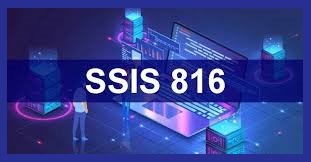Understanding SSIS-816: A Deep Dive into Integration Services
In today’s data-driven world, managing and transforming data efficiently is crucial for businesses to stay competitive. One of the most widely used tools for data integration is SSIS-816, a version of SQL Server Integration Services. Whether you’re new to data integration or looking to refine your expertise, this guide will cover the essentials of SSIS, its benefits, and how to get the most out of this robust tool.
What is SSIS-816?
SSIS-816 (SQL Server Integration Services) is a platform for building data integration and transformation solutions. It allows users to extract, transform, and load (ETL) data from various sources. SSIS is part of Microsoft SQL Server, making it ideal for users who need to manage data in Microsoft ecosystems.
The SSIS version includes advanced capabilities that improve the performance and flexibility of ETL processes. The tool can handle large volumes of data, provide powerful data transformation capabilities, and integrate with various platforms and services.
Key Features of SSIS-816
SSIS-816 is equipped with several notable features that make it a go-to tool for data professionals:
- Data Integration: SSIS can seamlessly integrate data from multiple sources, including SQL databases, flat files, Excel files, and cloud-based data warehouses. This makes it a versatile option for managing large datasets across different environments.
- Data Transformation: SSIS-816 offers many transformations, including sorting, filtering, aggregation, and more. These transformations ensure the data is shaped and refined to meet business needs.
- Automation and Scheduling: SSIS allows users to automate ETL processes through scheduling. Data workflows can be set to run at specific times or triggered by certain events, saving IT teams time and effort.
- Error Handling: This version of SSIS includes improved error handling, allowing users to troubleshoot and resolve issues in data workflows more effectively.
- Performance Tuning: SSIS-816 has performance enhancements, including better memory management and execution logging, ensuring that large ETL processes run smoothly and efficiently.
- Integration with Azure Services: Cloud computing is becoming a staple in data management, and SSIS allows integration with Azure Data Services, enabling users to migrate and manipulate data across on-premises and cloud platforms.
Getting Started with SSIS-816
If you are new to SSIS, here’s a step-by-step guide to get you started with building your first ETL package:
Step 1: Install SSIS-816
First, ensure you have installed SQL Server Data Tools (SSDT) with the SSIS-816 extension. This will give you access to the development environment for creating and managing SSIS projects.
Step 2: Create a New SSIS Project
Open SSDT and create a new SSIS project. You will be prompted to name your project and select a location to save it.
Step 3: Define Data Sources
Once your project is created, you must define your data sources. SSIS supports various data types, including SQL Server databases, flat files, and Excel sheets.
Step 4: Create Data Flow Tasks
Data flow tasks are the heart of SSIS-816. These tasks allow you to move and transform data between sources. You can add various transformations to your data flow, such as filtering out duplicates or sorting data alphabetically.
Step 5: Configure Error Handling
SSIS allows you to configure error handling at various points in the ETL process. You can log errors or redirect rows that fail transformations, making it easier to troubleshoot and maintain the integrity of your data.
Step 6: Automate and Schedule ETL Tasks
Finally, you can automate your SSIS package by setting up a schedule. This can be done using SQL Server Agent, which allows you to set specific times or events to trigger your data workflows.
Best Practices for Using SSIS-816
To maximize the effectiveness of SSIS-816, here are some best practices that data professionals should follow:
- Optimize Performance with Parallel Processing
SSIS supports parallel processing, meaning that multiple data flows can run simultaneously. This improves performance, especially when working with large datasets. Ensure your SSIS package is designed to take full advantage of this feature.
- Use Variables for Flexibility
Using variables in SSIS-816 can add flexibility to your data workflows. For instance, you can dynamically define file paths or control your package’s flow based on specific conditions.
- Implement Robust Error Handling
Proper error handling is critical in SSIS-816. Ensure you have implemented mechanisms to log errors and redirect failed rows so your ETL processes don’t fail silently.
- Test and Validate Data Thoroughly
Before deploying any SSIS package, thoroughly test and validate the data transformations. This ensures the data is accurate and meets the required standards before loading it into the destination.
Common Challenges in SSIS-816 and How to Overcome Them
While SSIS is a powerful tool, users may encounter several challenges. Here’s how to address some common issues:
- Performance Bottlenecks
Performance bottlenecks can occur when working with large datasets. To mitigate this, consider breaking down your data workflows into smaller chunks and optimizing SQL queries in your SSIS packages.
- Connection Errors
Connection issues between SSIS and data sources can be frustrating. Ensure you have the correct permissions and that your network configuration allows seamless connectivity between data sources.
- Error Handling
Some errors can be problematic to diagnose, even with built-in error handling features. Always enable detailed logging for your SSIS packages. This will give you insights into where the error occurred and how to resolve it.
Advanced SSIS-816 Techniques
For experienced SSIS users, here are some advanced techniques to enhance your ETL processes:
- Using Script Components
Script components allow users to create custom transformations using C# or VB.NET. This can be particularly useful when SSIS’s built-in transformations don’t meet your needs.
- Implementing Data Quality Services
Data quality is crucial in any ETL process. SSIS allows integration with Data Quality Services (DQS), which can cleanse and standardize data before loading it into a destination.
- Leveraging the Azure Integration Runtime
If you work in a hybrid environment, you can use the Azure Integration Runtime to move data between on-premises and cloud-based data sources. This enables you to create seamless workflows that handle data regardless of where it’s stored.
Final Thoughts on SSIS-816
SSIS-816 is a robust tool for any data professional looking to streamline their ETL processes. With its advanced features, performance enhancements, and cloud integration capabilities, SSIS-816 stands out as a powerful solution for modern data integration challenges.
However, mastering SSIS-816 requires time, practice, and continuous learning. Whether you’re a beginner or a seasoned expert, keeping up with the latest updates and best practices will help you get the most out of this tool.
Questions and Answers
Q: How does SSIS-816 improve data integration for cloud environments?
A: SSIS-816 integrates seamlessly with Azure Data Services, allowing users to quickly move and transform data between on-premises databases and cloud-based platforms. This helps businesses leverage the power of the cloud for data processing.
Q: What are the main advantages of SSIS-816 over older versions?
A: SSIS-816 offers improved performance, enhanced error handling, and cloud integration. It also supports more data sources, making it a more flexible tool for modern ETL needs.
Q: Can SSIS-816 handle large datasets efficiently?
A: Yes, SSIS-816 is optimized for handling large datasets. Features like parallel processing and performance tuning help ensure that even massive data flows are processed efficiently.



